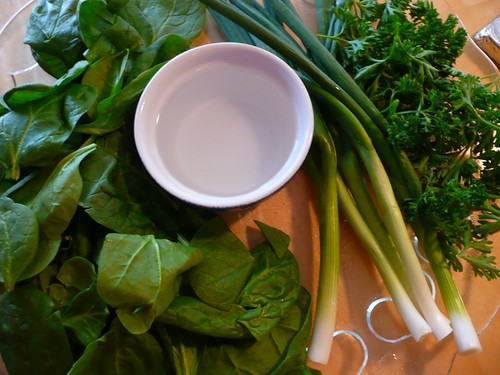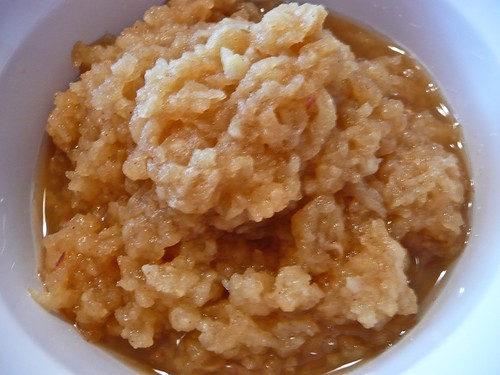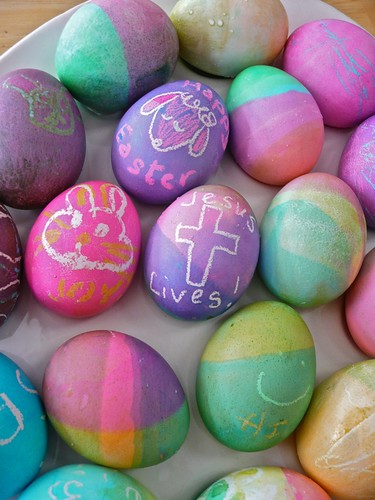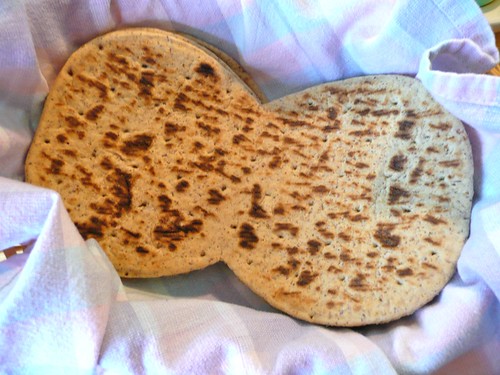Welcome to The Journey! This post is now several years old. I never dreamed at the time I put it together how many people would land here from all over the world every year as they make the effort to soak in the goodness of God's faithfulness in keeping his covenant relationship to his people. To any Jewish reader coming here in the process of preparing for your Passover celebration, you will note that this particular celebration points to Jesus as the eternal fulfillment of God's covenant. I want to acknowledge that a Christian script might not sit well with you if that's the case, and I hope you will read my response to someone in that situation in the comments, including the Jewish heritage in my own family.
The introduction and instructions for preparing this special meal are found here. This is the script to be provided for each family member. (Updated: A more condensed, hopefully smoother flowing version of the script is here.) God bless you as you make efforts toward deeper meaning and connection to him. I hope what I've done here can serve as some small help in that.
The introduction and instructions for preparing this special meal are found here. This is the script to be provided for each family member. (Updated: A more condensed, hopefully smoother flowing version of the script is here.) God bless you as you make efforts toward deeper meaning and connection to him. I hope what I've done here can serve as some small help in that.
Part One: Introductory Blessings
All gather around the table and stand quietly. The mother lights the candle.
All pray: Blessed are you, O Lord our God, King of the Universe. You have given us life, provided for our needs, and brought us to this season. Let your light shine on us in blessing and bring us peace.
All are seated.
Leader 1: As Jesus observed the traditional Jewish Passover meal with his disciples during the last week of his life, he brought the people of God from the Old Covenant to the New Covenant. God had shown his concern for His people through all of history. Just as God sent Moses to rescue the Israelites from captivity in Egypt, he also lovingly sent His Son to redeem fallen man from slavery to sin. By sacrificing Himself, Christ brought reconciliation and freedom to all who believe in him. Tonight we will use passages from both the Old and New Testaments to help us more fully appreciate Jesus' celebration of the Passover with his disciples during his last meal with them.
All read: When the hour came, Jesus and his apostles reclined at the table. And he said to them, “I have eagerly desired to eat this Passover with you before I suffer. For I tell you, I will not eat it again until it finds fulfillment in the kingdom of God.” (Luke 22:14-16)
Part Two: Traditional Passover Blessing
Leader 2: The celebration of the Passover includes four cups of wine. The cups represent the four declarations of God’s promised deliverance to Egypt, each beginning with an “I will...” in Exodus 6:6-7.
The first cup of wine is poured.
Leader 1: The first cup is the cup of sanctification, referring to God’s promise to set his people apart from the Egyptians. God spoke to Israel:
All read: “I am the Lord, and I will bring you out from under the yoke of the Egyptians.”
Leader 2: The first act of the Passover meal is this traditional Jewish prayer of blessing, known as the Kiddush.
All raise cups and pray: Blessed are you O Lord our God, King of the Universe, who creates the fruit of the vine. You have chosen us among all peoples and sanctified us to be used for your service.
All drink the first cup.
Leader 1: The next act of the Passover meal is the eating of the greens. They remind us that nature returns to life in the springtime. They are dipped in salt water to remind us of the tears of a people who were held captive in slavery.
All pray: Blessed are you O Lord our God, King of the Universe, Creator of the fruit of the earth.
All take a piece of green vegetable, dip in salt water and eat.
All pray: Blessed are you O Lord our God, King of the Universe, Creator of the fruit of the earth.
All take a piece of green vegetable, dip in salt water and eat.
Leader 2: The third act of the Passover meal is the breaking of the matzah, or unleavened bread. (Holds up a piece of the Matzah and breaks it in half.) This is the bread of suffering, which the Jews ate in the land of Egypt. It reminds us of people everywhere today who are hungry and without freedom.
Part Three: The Questions (Haggadah)
Part Three: The Questions (Haggadah)
Child 1: Why is this night different from all other nights?
Leader 1: When the Israelites were slaves in Egypt, God miraculously showed them the way to safety by parting the Red Sea. Just like God saved them from slavery, he also saved us from our sin. Jesus died, rose again, and joined his Father in heaven, showing us the way, and preparing a place for us. Jesus said,

Child 1: Why do we eat the bitter herbs, this time dipped in sweet apples?

All read: “I am the Way, the Truth, and the Life. No one can come to the Father except through me.” (John 14:6)
Child 2: Why do we eat bitter herbs tonight at this special meal?
Child 2: Why do we eat bitter herbs tonight at this special meal?

Leader 1: The Jews ate bitter herbs on the Passover night because their fathers were slaves in Egypt and their lives were made bitter. As Christians, we taste the herbs to remember the pain of Jesus’s death.
Child 1: Why do we eat the bitter herbs, this time dipped in sweet apples?

Leader 2: We dip the bitter herbs into the sweet apples, or haroseth, as a sign of hope. The haroseth represents the mortar that the Jews had to use to hold the bricks together when they were slaves. But it is also sweet, because the bitterness of the Israelites’ slavery was sweetened by the hope of freedom. We who follow Jesus are reminded that by sharing in the bitterness of His sufferings, we strengthen our hope.
All read: We have peace with God through our Lord Jesus Christ, through whom we have gained access by faith into this grace in which we now stand. And we rejoice in the hope of the glory of God. Not only so, but we also rejoice in our sufferings, because we know that suffering produces perseverance; perseverance, character; and character hope. And hope does not disappoint us, because God has poured out his love into our hearts by the Holy Spirit, whom he has given us. (Romans 5:1-5)
All take a piece of parsely, dip it in the haroseth, and then eat.

All take a piece of parsely, dip it in the haroseth, and then eat.
Child 2: Why do we eat the eggs at Passover?

Leader 1: Like the greens, they are a reminder of the new life that arrives in spring.
Child 1: Why do we have the leg bone of the lamb at the table when we celebrate the Passover meal?

Child 1: Why do we have the leg bone of the lamb at the table when we celebrate the Passover meal?

Leader 2: The lamb reminds us of the Passover lamb, which God commanded the Israelites to sacrifice to protect the lives of their families the night the angel of the Lord passed over them in Egypt. As Christians we speak of Christ as the perfect Lamb of God, sacrificed on the cross for us. By his death and resurrection, he makes it possible for us to have eternal life in heaven with God.
All read: For you know that it was not with perishable things such as silver or gold that you were redeemed from the empty way of life handed down to you from your forefathers, but with the precious blood of Christ, a lamb without blemish or defect. He was chosen before the creation of the world, but was revealed in these last times for your sake. Through him you believe in God, who raised him from the dead and glorified him, and so your faith and hope are in God. (1 Peter 1:18-21)
Child 2: Why do we eat Matzah at the Passover table?

Child 2: Why do we eat Matzah at the Passover table?

Leader 1: The blessing and breaking of the bread is an important part of the meal. It reminds us of how the Hebrew people left Egypt in a hurry and did not have time to prepare for the trip. They had no time to bake their bread. They could not wait for the yeast to rise, so they made it without the yeast into a flat bread. The sharing of pieces from a common loaf of bread was a powerful symbol of the oneness of the community. Paul wrote about this to the early Christians:
All read: Is not the bread that we break a participation in the body of Christ? Because there is one loaf, we who are many, are one body, for we all partake of the one loaf. (1 Corinthians 10:17)
The loaf is distributed.
All pray: Blessed are you, O Lord our God, King of the Universe, who brings forth bread from the earth.
The loaf is distributed.
All pray: Blessed are you, O Lord our God, King of the Universe, who brings forth bread from the earth.
Each person eats his or her portion.
Child 1: Why do we drink from the fruit of the vine?

Child 1: Why do we drink from the fruit of the vine?

Leader 2: The Jews drank from each cup of wine as an act of blessing and thanksgiving to God for his promises and acts of deliverance, much like we use wine to toast or celebrate someone’s special event or achievement.
A second cup of wine is poured.
Leader 1: The second cup is the cup of deliverance. God spoke to Israel,
All read: “I will free you from being slaves to them.”
All raise cups and pray: Blessed are you, O Lord our God, King of the Universe, Creator of the fruit of the vine. You have freed us from captivity to others, and also from captivity to our own sin.
All drink the second cup.
Part Four: Hallel—Psalms of Praise
Leader 2: In the Passover feast, before the meal is eaten, the first two psalms of the Hallel are recited. The Hallel is found in Psalms 113-118. These are the hymns of praise which the Jews recited at all of their great feasts.
All: Praise the Lord. O servants of the Lord, praise the name of the Lord! Let the name of the Lord be praised, both now and forevermore. From the rising of the sun to the place where it sets, the name of the Lord is to be praised. (Psalm 113:1-3)
The meal is eaten. When all have finished, the father takes and distributes another piece of unleavened bread.
Leader 1: During his last supper with the disciples, Jesus took bread, gave thanks, broke it and gave it to them saying, “This is my body given for you; do this in remembrance of me.” (Luke 22:19)
All eat the bread.
The third cup of wine is poured.
Leader 2: The third cup is the cup of redemption. God said,
All read: “I will redeem you with an outstretched arm.”
Leader 1: After Jesus and his disciples had finished their meal, Jesus took the third cup and said, “This cup is the new covenant in my blood, which is poured out for you.” (Luke 22:20)
All raise cups and pray: Blessed are you O Lord our God, King of the Universe, Creator of the fruit of the vine. As you redeemed the Israelites by leading them to the promised land, you also redeemed us by your outstretched arms on the cross, purchasing for us the promise of eternity with you in heaven.
All drink the third cup.
The fourth cup of wine is poured.
Leader 2: The fourth cup is the cup of ingathering. God said,
All read: “I will take you as my own people, and I will be your God.”
Leader 1: In the book of Revelation, John has a dreamlike vision of the scene in heaven after Jesus had returned from his mission on earth. John sees Jesus as a Lamb, looking as if it had been slain, standing in the center of the throne. The heavenly beings sang this new song to him: “You are worthy to take the scroll and to open its seals, because you were slain, and with your blood you purchased men for God from every tribe and language and people and nation. You have made them to be a kingdom and priests to serve our God.” (Revelation 5:9-10)
All raise the cup and pray: Blessed are you O Lord our God, King of the Universe, Creator of the fruit of the vine. As you gathered the tribes of Israel to yourself and marked them as your own people, now through Christ you have made us your own, along with people from every nation on earth who place their faith in you. Strengthen us to serve you joyfully in gathering more people, both near and far, to know you.
All drink the last cup.
Part Five: The Concluding Hallel
Leader 2: Matthew’s gospel tells us that Jesus and his disciples followed the Jewish tradition to the very end, concluding as we will tonight by singing the final Hallel.
All read: When they had sung a hymn, they went out to the Mount of Olives. (Matthew 26:30)
There’s No One Like Our God (words adapted from Psalm 113:4-9)
(sung along to song performed by Cole NeSmith, available on iTunes)
There’s no one like our God, no one at all
He gave His Son for us, Jesus the Lord
Who can love us like He does, no one at all
Oh how we love you Lord
You are high above all nations
Your glory shines above the heavens
Humbled yourself to love and save us
Be praised through endless generations
(Chorus)
You lift the needy from the ashes
And seat them high up with the princes
You give the barren woman healing
She’ll dance for joy like the mother of children
(Chorus)
Oh how we love you Lord!
Oh how we love you Lord!
Oh how we love you Lord!
Oh how we love you Lord!
A second cup of wine is poured.
Leader 1: The second cup is the cup of deliverance. God spoke to Israel,
All read: “I will free you from being slaves to them.”
All raise cups and pray: Blessed are you, O Lord our God, King of the Universe, Creator of the fruit of the vine. You have freed us from captivity to others, and also from captivity to our own sin.
All drink the second cup.
Part Four: Hallel—Psalms of Praise
Leader 2: In the Passover feast, before the meal is eaten, the first two psalms of the Hallel are recited. The Hallel is found in Psalms 113-118. These are the hymns of praise which the Jews recited at all of their great feasts.
All: Praise the Lord. O servants of the Lord, praise the name of the Lord! Let the name of the Lord be praised, both now and forevermore. From the rising of the sun to the place where it sets, the name of the Lord is to be praised. (Psalm 113:1-3)
The meal is eaten. When all have finished, the father takes and distributes another piece of unleavened bread.
Leader 1: During his last supper with the disciples, Jesus took bread, gave thanks, broke it and gave it to them saying, “This is my body given for you; do this in remembrance of me.” (Luke 22:19)
All eat the bread.
The third cup of wine is poured.
Leader 2: The third cup is the cup of redemption. God said,
All read: “I will redeem you with an outstretched arm.”
Leader 1: After Jesus and his disciples had finished their meal, Jesus took the third cup and said, “This cup is the new covenant in my blood, which is poured out for you.” (Luke 22:20)
All raise cups and pray: Blessed are you O Lord our God, King of the Universe, Creator of the fruit of the vine. As you redeemed the Israelites by leading them to the promised land, you also redeemed us by your outstretched arms on the cross, purchasing for us the promise of eternity with you in heaven.
All drink the third cup.
The fourth cup of wine is poured.
Leader 2: The fourth cup is the cup of ingathering. God said,
All read: “I will take you as my own people, and I will be your God.”
Leader 1: In the book of Revelation, John has a dreamlike vision of the scene in heaven after Jesus had returned from his mission on earth. John sees Jesus as a Lamb, looking as if it had been slain, standing in the center of the throne. The heavenly beings sang this new song to him: “You are worthy to take the scroll and to open its seals, because you were slain, and with your blood you purchased men for God from every tribe and language and people and nation. You have made them to be a kingdom and priests to serve our God.” (Revelation 5:9-10)
All raise the cup and pray: Blessed are you O Lord our God, King of the Universe, Creator of the fruit of the vine. As you gathered the tribes of Israel to yourself and marked them as your own people, now through Christ you have made us your own, along with people from every nation on earth who place their faith in you. Strengthen us to serve you joyfully in gathering more people, both near and far, to know you.
All drink the last cup.
Part Five: The Concluding Hallel
Leader 2: Matthew’s gospel tells us that Jesus and his disciples followed the Jewish tradition to the very end, concluding as we will tonight by singing the final Hallel.
All read: When they had sung a hymn, they went out to the Mount of Olives. (Matthew 26:30)
There’s No One Like Our God (words adapted from Psalm 113:4-9)
(sung along to song performed by Cole NeSmith, available on iTunes)
There’s no one like our God, no one at all
He gave His Son for us, Jesus the Lord
Who can love us like He does, no one at all
Oh how we love you Lord
You are high above all nations
Your glory shines above the heavens
Humbled yourself to love and save us
Be praised through endless generations
(Chorus)
You lift the needy from the ashes
And seat them high up with the princes
You give the barren woman healing
She’ll dance for joy like the mother of children
(Chorus)
Oh how we love you Lord!
Oh how we love you Lord!
Oh how we love you Lord!
Oh how we love you Lord!

6 comments:
wow, when did you start doing that with your kids? I am afraid Jasper will not pay attention and Eli would get stuck on the foods right now... just wondering
The first time we did it my kids were 8 and 10. Perfect ages, really. I've heard that people sometimes begin with just a small portion of it, and add each year as the kids can handle more.
Saw this on Pinterest. Charoset is not just "sweet jam" is represents the mortar that held together the bricks made by Jews in Egypt. You should really get a Haggadah and read it thoroughly. Wishing someone a Chag Pesach Sameachis not the same as saying Happy Easter; the holidays are different in kind and ritual and celebration (e.g., some families use an orange on the Passover plate for women). I'm sure you mean well, but Pesach isn't a holiday to be co-opted by modern Christians. Comparing this in Passover to that in Easter is trying to fit a circle into a square.
Melissa,
I was just going through 200 or more spam comments in my account, and came upon your comment there, so I published it. I hope you subscribed to the comments so you will see my reply.
First of all, thank you for taking the time to comment. There are MANY details of the Haggadah, such as the one about the haroseth representing mortar, that I left out, although since that stood out to you, I have edited the script to include it.
I'm sorry to hear that you take exception to the use of the Passover celebration in relation to Christ. In light of Christian teaching, however, it is Jesus himself who unmistakably connected himself to Passover in his careful observance of it before his death. This is a beautiful part of Christian tradition that too many Christians miss because they don't understand what he was doing.
My grandfather was a Jewish man who came from Russia and married my Norwegian grandmother early in the 20th century. I never had the privilege of knowing him, and I have always wished we had incorporated more of that heritage into our lives.
I did quite a bit of research before I arrived at this script. I described the process in this post before posting this script. My goal was to arrive at a script that I could introduce to my family for the first time, in consideration of the ages of my children. I felt that my best opportunity to include them was to keep it brief enough and interactive enough to hold their attention. As you mentioned, and as I found in my research, different Jewish families adapt the elements for their own use, which I think is a beautiful expression of the fact that we each reflect the image of God in ways that are unique. This script is merely one woman's approach, and some friends asked me to share it.
All of this said, please know that I am completely aware that Passover and Easter are not the same thing. They are, however, both part of my heritage. God's blessings to you!
bookmarked!!, I love your web site!
Thank you! If you do a meal, I would love to hear how it goes! 😊
Post a Comment